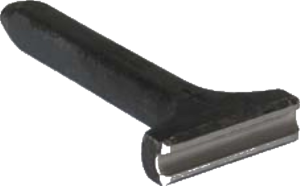Grooving Iron: Difference between revisions
From DT Online
mNo edit summary |
mNo edit summary |
||
| Line 10: | Line 10: | ||
=====Features and Uses===== | =====Features and Uses===== | ||
A '''[[Grooved Seam Joint]]''' is one of the most widely used methods for joining light and medium-gauge sheet metal. Choose a '''Grooving Iron''' slightly wider than the joint seam. The interlocking seam is supported on a '''[[Bench Block]]''', '''[[Blacksmith's Anvil]]''' or '''[[Mandrel Stake]]'''. The '''Grooving Iron''' is placed over it and struck sharply with a hammer to lock the seam. | |||
[[Category:Punches]] | [[Category:Punches]] | ||
[[Category:Sheet Metalwork]] | [[Category:Sheet Metalwork]] | ||
Latest revision as of 11:30, 22 July 2017
Description
A Grooving Iron or Hand Groover is used to lock together an interlocking Seam Joint as used in Tinsmithing and other forms of sheet metalworking.
Features and Uses
A Grooved Seam Joint is one of the most widely used methods for joining light and medium-gauge sheet metal. Choose a Grooving Iron slightly wider than the joint seam. The interlocking seam is supported on a Bench Block, Blacksmith's Anvil or Mandrel Stake. The Grooving Iron is placed over it and struck sharply with a hammer to lock the seam.
